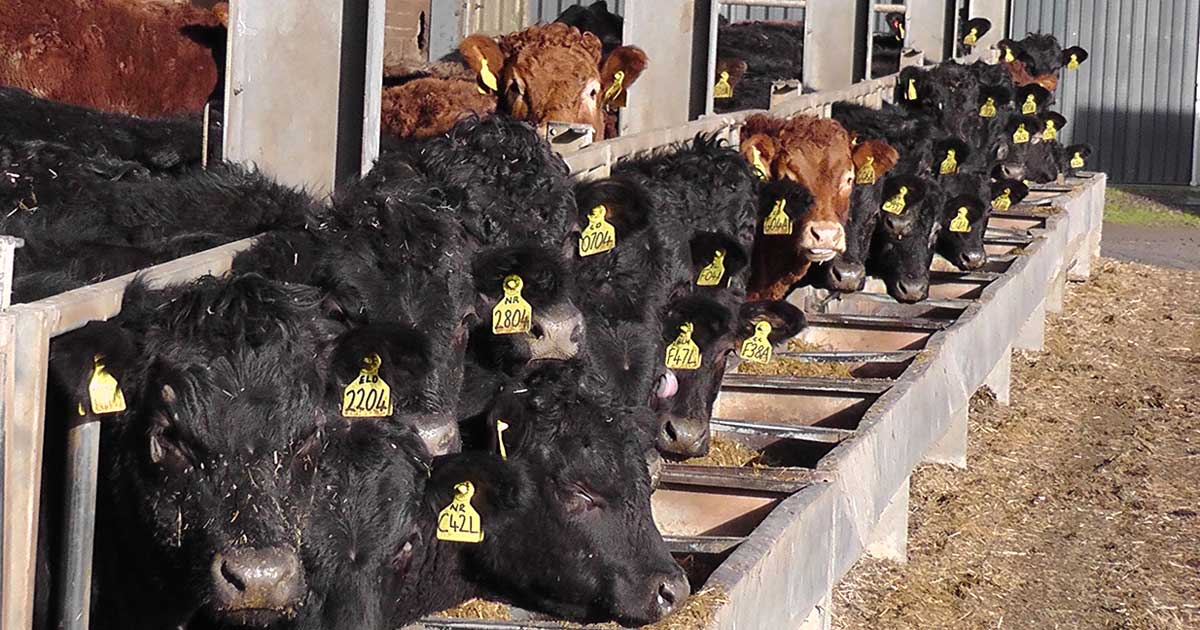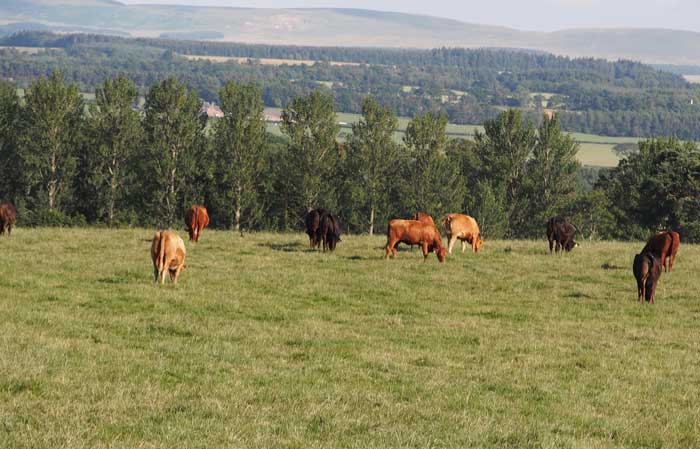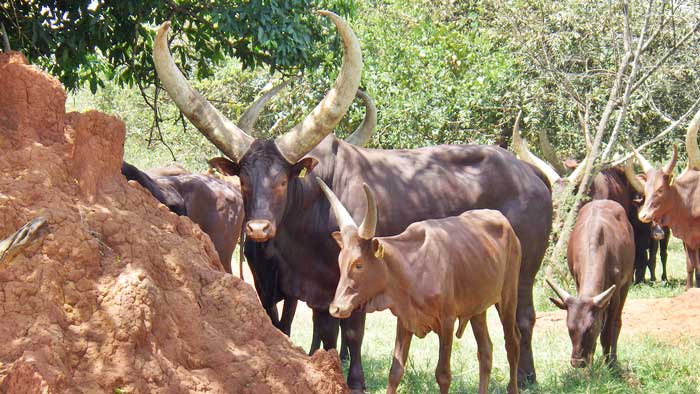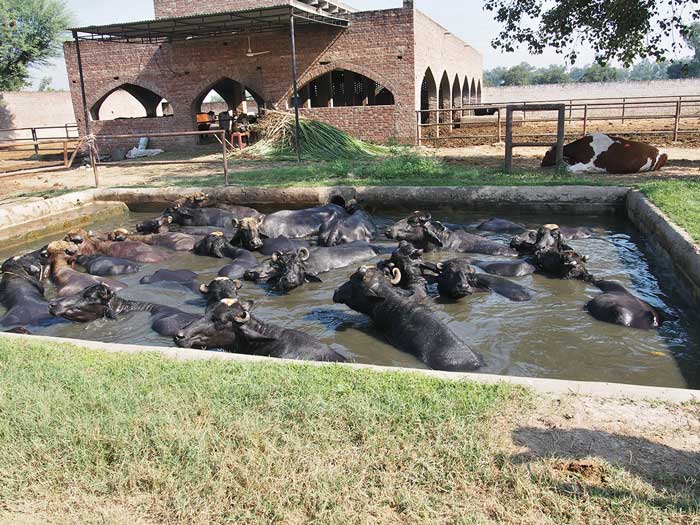27 Oct 2020
Helminth control in cattle
Neil Sargison discusses how vets can work with farmers to maintain responsible anthelmintic use and ensure herd health.

Figure 1. Despite unique identification, few UK and Irish producers routinely monitor the performance of their cattle. Therefore, the impact of helminth parasites and effectiveness of anthelmintic drug treatments is unknown.
Control of helminth parasites of cattle and buffalo, such as Haemonchus contortus and Haemonchus placei; liver, rumen and blood flukes; and Echinococcus tapeworms, is essential globally, especially where warm and humid climatic conditions – and pastoral agricultural management – provide opportunities for the survival and development of environmental stages and completion of parasitic life cycles.
Ostertagia ostertagi gastrointestinal nematodes, Dictyocaulus viviparus lungworms and Fasciola hepatica liver flukes are important helminth parasites of cattle kept in temperate and wet regions, such as the UK and Ireland.
These parasites can cause production loss through animal deaths, diarrhoea, respiratory disease, anaemia, reduced milk yields, poor growth rates and illthrift.
Control of the human tapeworm Taenia saginata, in its intermediate cattle hosts, is also important to ensure public health.
For most developed cattle production systems, the availability of relatively cheap and easy‑to‑use broad‑spectrum anthelmintic drugs limits the impact of gastrointestinal nematodes, lungworms and liver flukes to subclinical illthrift – or reduced milk yields – with only occasional clinical disease outbreaks.
Illthrift is generally only recognised when body condition and growth rates are monitored and compared to production targets, but in the absence of such management, many UK and Irish farmers fail to recognise the impact of helminth parasites in their herds (Figure 1).
Conversely, the devastating impacts of helminth parasites – such as Haemonchus species, Fasciola species and Echinococcus granulosus – are well known in underdeveloped countries where effective drugs are not so readily available.

Principles of helminth control
The established principles of gastrointestinal roundworm, lungworm, liver fluke and intermediate host stage tapeworm control are to reduce host exposure to infectious larval, metacercarial or egg stages to levels that will allow for the development of protective immunity, while enabling parasitic stage burdens to be manageable.
Helminth control strategies are based on the integration of evasive host management (for example, by grazing naive or susceptible animals in environments that are predicted to harbour low levels of infectious stage challenge) and anthelmintic drug treatments to interrupt the parasites’ life histories, by suppressing egg or life cycle stage one shedding by infected hosts.
Implementation of these strategies requires a sound understanding of the complex environmental and host factors required to complete the parasite life histories.
The timing of these approaches is governed by the annual production cycle and management of the host cattle, resulting in the seasonal presence of naive or less immunologically capable animals, and by the environmental conditions that favour infectious stage development and survival.
Helminth control programmes must, therefore, be tailored to the needs and conditions present in individual farms or production groups.
Understanding of the prevailing farming systems and environments is needed to draw inferences on the relationship between pasture contamination, the availability of infectious stages on pasture and the accumulation of infection in animals (Figure 2).

Practical realities of helminth control
In practice, complexities of the principles of sustainable helminth control prevent the widespread adoption of rational programmes for individual cattle herds and groups.
In contrast, the availability of a range of relatively inexpensive broad‑spectrum benzimidazole, imidazothiazole and macrocyclic lactone drugs for nematode control – and benzimidazole, salicylanilide derivative and benzenesulfonamide drugs for the control of different parasitic stages of liver flukes – coupled with persistent action, depot or pulse release formulations, practical administration methods, and products combining different drugs, afford straightforward options for helminth control in cattle herds.
Most UK and Irish cattle producers administer these anthelmintic drugs singly or in combinations, with the understandable, but irrational, goal of eradicating parasites from their animals.
Pour-on combinations of macrocyclic lactones and salicylanilide derivatives are widely used for the one‑fits‑all control of gastrointestinal nematodes, lungworms and liver flukes, as well as various ectoparasites.
While imperfect, these strategies are generally effective in preventing clinical disease due to helminth parasitism. However, without monitoring animal performance or drug efficacy, their actual impact on animal production efficiency and cost benefits are unclear.
Questions must be asked concerning the responsibility of dependence on regular anthelmintic drug treatments for the control of gastrointestinal nematodes, lungworms and liver flukes, with reference to gaps in the acquisition of protective immunity, parasite adaptation to changing patterns of farm management, and climate change.
These questions provide opportunities for veterinary practitioners to work together with both research scientists and livestock producers to meet the challenge of responsible anthelmintic use and ensure cattle health.
Parasitic helminth genetic adaptation
Helminth parasites have high reproductive rates, large genomes with large numbers of genes, and high levels of polymorphism. For example, the H contortus genome is 280 megabases with about 22,000 protein-coding genes. The Teladorsagia circumcincta (closely phylogenetically related to O ostertagi) genome assembly is less refined, but appears to be larger and more polymorphic.
The F hepatica genome is estimated to be about 1.3 gigabases, albeit this very large size may, in part, be due to an imperfect assembly of overlapping scaffolds and contigs. These traits confer genetic adaptability to the effects of changing climate or livestock management on free-living stages, and of the exposure of parasitic stages to anthelmintic drugs.
Several examples of small ruminant gastrointestinal nematode adaptation to environmental and management change have been described in the UK and Ireland. The same conditions have been exploited by F hepatica liver and Calicophoron daubneyi rumen flukes affecting cattle.
Cooperia species and Nematodirus helvetianus are dose‑limiting species for macrocyclic lactones; reports exist of these cattle gastrointestinal nematodes, which are generally not considered to be important pathogens, causing disease when afforded a competitive advantage by macrocyclic lactone pour-on treatments selectively eliminating O ostertagi.
Anthelmintic resistance
Resistance to single active, broad‑spectrum benzimidazole, imidazothiazole and macrocyclic lactone anthelmintics is widespread in most major small ruminant trichostrongyle gastrointestinal nematode species globally, while amino acetyl nitrate derivative drug resistance is emerging and narrow‑spectrum salicylanilide resistance is widespread in H contortus.
Benzimidazole and macrocyclic lactone resistance have been reported in Cooperia, Haemonchus and O ostertagi cattle gastrointestinal nematodes. However, caution is required in interpreting phenotypic responses to drug treatment, because these may be due to stage‑specific activity or poor bioavailability (for example, when administered as pour‑ons), as well as genetic anthelmintic resistance.
Benzimidazole resistance has been confirmed genotypically in cattle, buffalo and small ruminants using isotype-I β-tubulin single nucleotide polymorphism (SNP) markers. Triclabendazole resistance is widespread in Fasciola globally and salicylanilide resistance has been reported in cattle.
Reports of albendazole resistance are inconclusive because the inherent efficacy of the drug against adult Fasciola stages, for which products are licensed, is less than 100 per cent.
Resistance to most anthelmintic drugs is suspected in various species of human-specific and zoonotic helminths (some of which are listed as neglected tropical diseases by the World Health Organization), albeit study of human helminthiases is more challenging than in livestock.
Anthelmintic resistance will inevitably have insidious effects on the economics and environmental consequences of cattle and buffalo farming, due to failure to control production‑limiting helminth diseases and consequences of greater resources required for animals to reach slaughter weights.
These effects will impact both on individual producers, and in the global contexts of food production and climate change mitigation (Figure 3).

Most livestock anthelmintic resistance research has been conducted in small ruminants in which the problem first emerged; these effects are now apparent. Therefore, a need exists to draw on expertise gained from small ruminant studies to identify practical cattle gastrointestinal roundworm and lungworm control strategies.
These should integrate grazing management and use of anthelmintic drugs in specific agricultural and environmental contexts, incorporating anthelmintic resistance mitigation, and exploring the exploitation of host genetic adaptation, use of natural xenobiotics and vaccine development.
Engagement with producers on responsible control and anthelmintic resistance mitigation
The instigation of planned cattle and buffalo health management is notoriously challenging. It is not possible to address all of the problems facing individual farmers and livestock keepers, and it is often necessary to start with specific known or obvious infectious diseases as a means of engagement.
Gastrointestinal nematodes, lungworms and liver flukes are foremost animal health challenges in pastoral livestock production systems around the world, impacting on sustainably efficient food production. Their impact is greatest under intensive management systems that use available pastures and result in the highest levels of infectious larval challenge, and will inevitably be increased as livestock production efficiency must improve to meet global needs for food, resulting in animal deaths and illthrift, particularly in the regions most sensitive to climate.
These concepts are well recognised; therefore, planned helminth control affords a pragmatic method of engagement with commercial farmers in developed agricultural regions – and with smallholder livestock keepers in lower and middle income countries (LMICs) – on the broader topics of improved production efficiency through animal health management (Figure 4), and better environmental stewardship.

Practical advice has been formulated for small ruminant farmers and keepers to reduce the risks of emergence and spread of anthelmintic resistance mutations, and has become integral to planned small ruminant health management. This is based on four principles:
Treatment of introduced animals with effective anthelmintic drugs or combinations to prevent gene flow.
Ensuring roundworms and flukes are exposed to an effective anthelmintic drug concentration, albeit the impact of underdosing on anthelmintic resistance selection is unknown and will depend on the genetics of resistance to different drug groups.
Refugia management, whereby consideration is given to the timing or frequency of anthelmintic treatments and numbers of animals treated, so that only a small proportion of the total parasitic-stage and available to the host free‑living population is exposed to the anthelmintic.
Monitoring drug efficacy and the impact of helminth control measures at farm and production group levels.
The complexities of helminth control principles and strategies to reduce selection pressures for anthelmintic resistance are often cited as reasons for poor sheep farmer uptake of best practice advice.
Nevertheless, these complexities are unavoidable – and compromises solely aimed at simplifying advice to make it more acceptable to livestock producers or marketable are unhelpful.
In the absence of genotypic markers for resistance to each of the broad‑spectrum anthelmintic drugs (apart from the three isotype-I β-tubulin SNPs conferring resistance to benzimidazole drugs), and given the only recent development of high throughput platforms or pen-side tests for their field use, empirical evidence in support of advice on reducing anthelmintic resistance selection pressure is predominantly based on theoretical models.
Refugia management is based on the premise that once the numbers of parasite stages in a refuge from drug exposure is reduced to a low level, the progeny of parasites surviving treatment of their hosts contribute to a significant proportion of the subsequent total parasite population.
Therefore, if the parasites survive treatment due to being genetically drug resistant, the frequency of resistant nematodes in the total population increases, followed by an increase in the size of the parasite population as subsequent anthelmintic treatments are ineffective.
This can eventually lead to suboptimal small ruminant production efficiency or clinical disease outbreaks that cannot be controlled using anthelmintic drugs.
Cattle producers must recognise that in the face of high levels of anthelmintic resistance, the global focus of helminth control needs to move away from attempts to eliminate helminth parasite populations towards the adoption of management and anthelmintic drug treatment strategies aimed at maintaining adequate health in the face of a low level of challenge. Veterinary practitioners and paravets in LMICs with poor veterinary infrastructures are ideally placed to disseminate this imperative message.
Depending on the agricultural system, these strategies may involve the integration of evasive grazing management with strategic drug treatments targeted towards individual animals that will benefit, or have an epidemiological impact, while leaving others untreated as a source of refugia.
A major challenge for refugia-based methods, for the control of gastrointestinal nematodes in small ruminants, has been to decide which animals to treat and which to leave untreated.
Weight gain of growing lambs and milk yield of dairy goats have been developed as indices in temperate climatic conditions where the predominant gastrointestinal nematode genera are Teladorsagia and Trichostrongylus.
Conjunctival mucous membrane colour has been developed as an index for the sustainable control of the blood-feeding H contortus. The system – the Faffa Malan Chart; referred to as FAMACHA – has been adopted in smallholder farms in southern Africa, and in large‑scale sheep and goat farms in parts of Australia, Brazil and North America where haemonchosis is endemic.
The simplicity of the method of using a conjunctival mucous membrane colour chart, to allocate a score of one to five, has resulted in its widespread adoption as a means of engagement with livestock keepers – both in the targeted selective treatment of haemonchosis, and as a general index of animal health and nutrition.
Veterinary practitioners and paravets now need to work with farmers and livestock keepers to develop and evaluate similar indices for the targeted selective treatment of helminth parasites in cattle. For example, these may include calf growth rates and cow milk yields in the control of ostertagiosis, or conjunctival mucous membrane colour in the control of haemonchosis and fasciolosis.
At the same time, veterinary practitioners and paravets need to engage with research scientists in the development of molecular markers for anthelmintic resistance in different drug groups; and practical post-genomic tools and high-throughput, affordable platforms for their use with which to monitor and refine refugia-based anthelmintic resistance mitigation strategies for cattle and buffalo.
Knowledge exchange on responsible drug use to ensure sustainable production
Planned animal health management – let alone responsible anthelmintic drug use – are low on the agenda of most cattle producers and veterinary businesses around the world, where the economic realities and political uncertainties surrounding complex business models predominate.
Furthermore, most producers don’t regularly monitor the performance of their animals and, therefore, are unaware of the impact of reduced anthelmintic drug efficacy.
Therefore, a need exists to heighten awareness of the need for anthelmintic resistance mitigation strategies.
In the UK and Irish context, formal veterinary practice client meetings with invited “expert” speakers are less impactful than direct on-farm conversations between farmers and their vets.
Veterinary practitioners need to demonstrate an interest in their clients’ farming businesses to allow these relationships to be fruitful, but some modern “pay-per-minute” veterinary practice models create barriers in this regard. Farmers differ in their acceptance of – and receptiveness towards – new strategies; therefore, veterinary involvement in the establishment of cattle producer groups and monitor farms can be helpful.
Likewise, experiences of development of educational methods for livestock keepers and paravets in LMICs suggest that formal meetings, leaflets and other didactic formats of knowledge transfer have limited impact.
Participatory knowledge exchange meetings with small groups of producers are much more effective in raising awareness and disseminating best practice advice on animal health management.
It is important to consider helminth control and anthelmintic resistance mitigation strategies as part of a broader topic of improved production efficiency through planned animal health management. This needs to be undertaken in the context of the whole agricultural system in which the livestock are kept.
Advice on the integration of anthelmintic resistance mitigation – and reiteration of the principles of parasite control – needs to be supported by scientific research (for example, outlining the economic impact of failure to control helminth parasites, demonstrating the impact of specific management practices on genetic selection for anthelmintic resistance, or showing the emergence and spread of resistance in cattle and buffalo populations), and monitoring of the impact of management changes on farms or in individual groups of cattle and buffalo.
